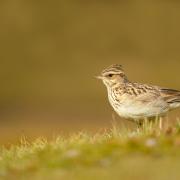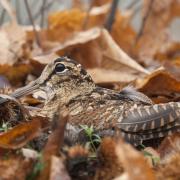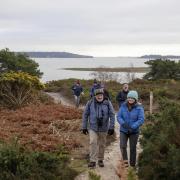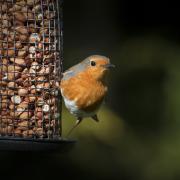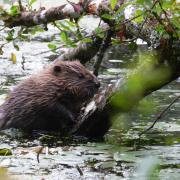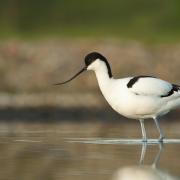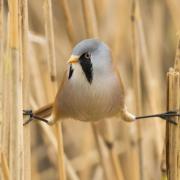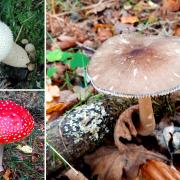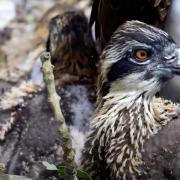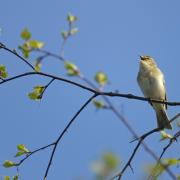Seal sightings on our coast are on the rise, which in turn has helped Dorset Wildlife Trust’s Seal Monitoring Project to discover more about these endearing visitors

If you’ve visited Studland Bay or Poole Harbour recently, you might have seen Smiley, or even met her, as she’s keen on trying to clamber into passing kayaks. Smiley is a young grey seal, named not just for her playful personality but also because she has a mark on her neck that’s shaped like a smiley face. She is just one of the many seals that have been recorded in the Dorset Wildlife Trust’s Seal Monitoring Project.
The initiative was set up a year ago by Julie Hatcher, Marine Awareness Officer at the Dorset Wildlife Trust (DWT). “Quite a few people had said ‘We often see seals in such-and-such a place’ and I wondered whether it was the same seal or a different seal? And why that spot?” says Julie, who is based at the DWT Marine Wildlife Reserve in Kimmeridge. “We had two or three sightings a year at Kimmeridge, and always a solitary seal. So we wanted to find out if there were any resident or semi-resident seals, how many there are and whether they are just travelling through.”
Photographic records of the seals are crucial for monitoring. Identifying a seal by sight can be very difficult, especially if the animal is in the water rather than lying on the shore (“hauled out”). Distinctive markings can help - one seal last year had a prominent scar on her nose - but a photograph reveals each seal’s unique pattern of spots and marks. By comparing photographs it’s possible to identify, log and name individual animals.
As Julie explains, encouraging people to send in their records of seal sightings, particularly photos, has proved very fruitful. “Last year turned out to be a good year for seals and we had more sightings than usual at Kimmeridge and a pair at Portland Bill that hung around all summer. As a result we were able to start a photo ID catalogue to see if we were looking at the same seals.”
In the project’s first few months, seven different seals were added to the ID catalogue, and there were over 60 sightings. “We thought there might be just one or two seals on the odd occasion, so such good results made us feel the project was worthwhile,” Julie confesses. Seal spotting, she adds, is very much about being in the right place at the right time; kayakers who visit the less accessible parts of the coast tend to be particularly lucky. Should you be fortunate enough to spot a seal, it will be one of the two British species, the harbour seal (also called the common seal) or the grey seal. “The grey is the one we see the most of,” says Julie. “They tend to be on the open coast and are the ones you’ll see in Portland, Kimmeridge and Swanage. We also sometimes get harbour seals in Poole Harbour.”
Harbour and grey seals can be tricky to tell apart – juveniles look particularly alike. “They’re actually quite similar in colour; all seals are greyish!” laughs Julie. “We’ve had to get expert opinions for some of our photos. The grey seal tends to have a longer, Roman nose, especially if it’s a male, while the harbour seal has a more concave nose. People say that a harbour seal looks more catlike, and a grey seal more doglike.”
Seals only get together in groups for breeding, when they have to come ashore for pupping, usually in the early autumn. “There are no pupping colonies in Dorset, as far as we’re aware,” says Julie. “The seals we see are probably looking for good places to feed, or maybe looking for mates. If seal populations are expanding down in the south west they might start to expand in our direction.”
Seals value their privacy and tend to haul out onto sandy beaches or rocks that are exposed at low tide and away from people and dogs. “Though seals are fast and agile in the water, land really isn’t their medium and they’re a lot more vulnerable. They haul out after a good meal, when they want to digest and warm up, and if they’re constantly being disturbed, it’s not very healthy for them and also quite stressful.”
Dorset’s coastline tends to be too well frequented to be suitable for hauled-out seals, but there is a small population nearby; the Hampshire & Isle of Wight Wildlife Trust has recorded a colony of harbour seals in the Solent, and occasional visits from greys. Seals with satellite tags attached in France have also been recorded in Dorset.
Seals are a protected species and the Dorset Wildlife Trust publishes guidelines on wildlife watching that does not disturb plants or animals; one key principle is using binoculars, not proximity, for close viewing. “Although we love people to send photos of seals, we wouldn’t want them to disturb the seals to get that photo,” says Julie. Curious seals, however, may sometimes meet keen seal watchers halfway and approach of their own accord. “We run kayak safaris with glass-bottomed kayaks at Kimmeridge and there was one occasion when a seal popped up close to the Centre. We were trying to radio to the kayaks and then the seal popped its head up right by where they were,” recalls Julie, who has dived with seals. “It’s always a thrill when something like that happens –seals are lovely animals, they are so curious and playful. And there’s that interaction – while we’re watching them, they are very much watching us too!”
If you do spot a seal in Dorset or have taken a photo of one then please email Julie Hatcher kimmeridge@dorsetwildlifetrust.org.uk.
***
READ ON
• Saving barn owls in Dorset - Could apartment living be the answer for these former barn dwellers? Join Dorset Wildlife Trust’s campaign to restore our beleaguered barn owls
• Dorset walk - Wool and Coombe Heath - From the fascinating ruins of a 15th-century church to admiring views across a military firing range, Edward Griffiths easy five miler offers plenty of variety for a weekend stroll








